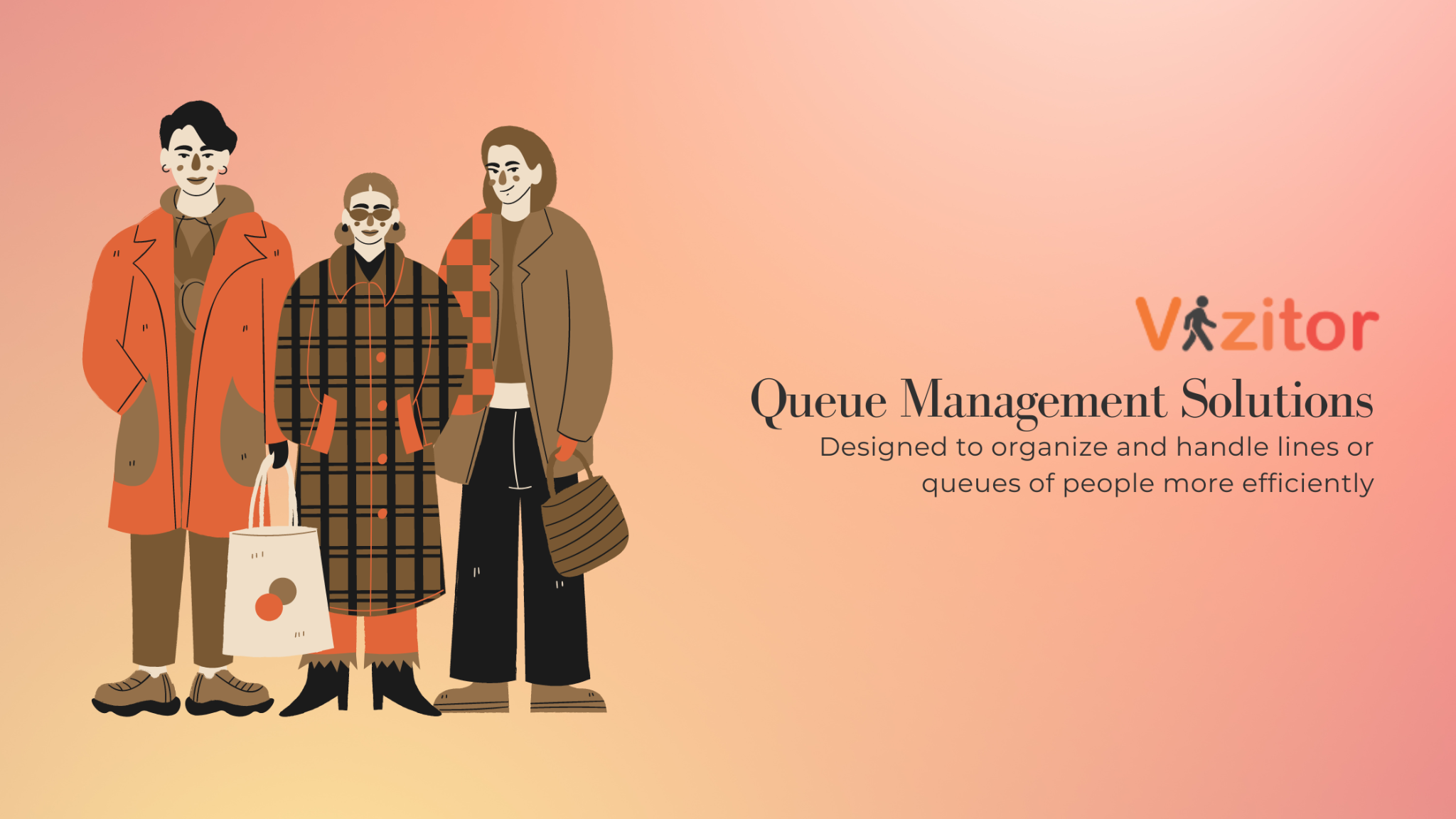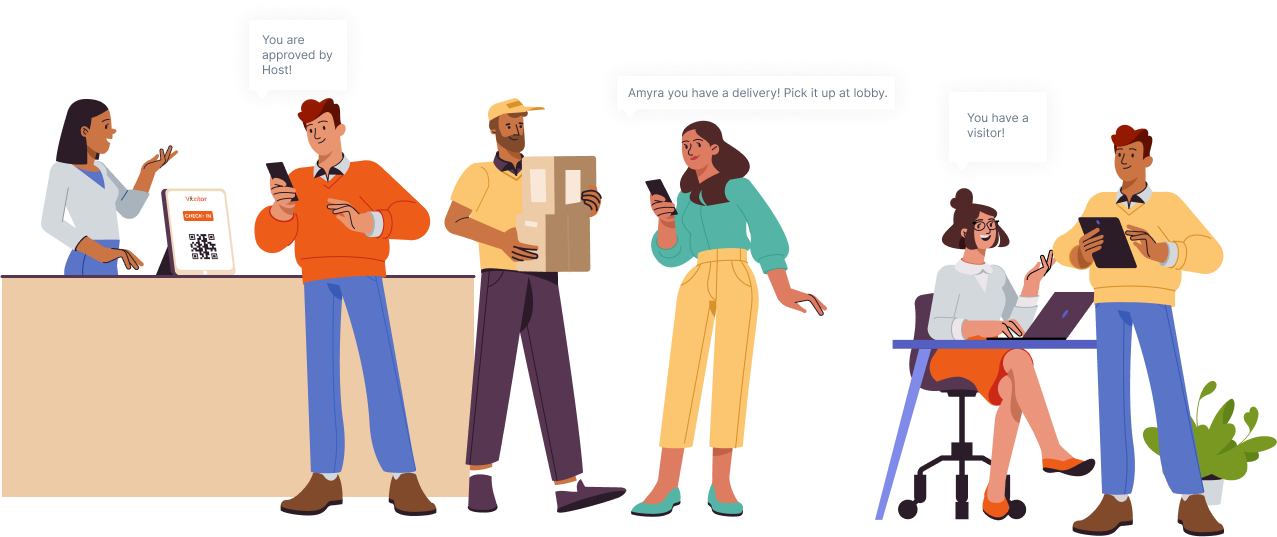Table of Content
Try Vizitor for Free!

Thu, Aug 29, 2024
Read in 14 minutes
Introduction
Did you know that 70% of people say they would leave a business after waiting just 5 minutes? In today’s busy world, managing queues well is crucial for keeping customers happy. Big companies like Starbucks, Walmart, and Emirates Airlines have started using advanced queue management systems to make their services faster and more efficient.
For example, Starbucks lets customers order and pay ahead of time, so they don’t have to wait long in the store. Walmart uses similar technology to handle busy shopping times more smoothly. Emirates Airlines uses queue management to make check-ins and security checks quicker for travellers.
These examples show how modern queue management system can make a big difference. By using these systems, businesses can cut down on wait times and improve service, leading to happier customers. In this blog, we’ll look at how these solutions work and why they’re important for businesses and their customers.
Understanding Queue Management Solutions
A queue management solution is a system designed to organize and handle lines or queues of people more efficiently. It helps businesses manage how customers wait for service, making the process smoother and less stressful. Whether it’s in a bank, hospital, retail store, or airport, a queue management system ensures that customers are served in an orderly and timely manner.
Types of Queue Management Solutions
There are several types of queue management systems, each with its own way of helping businesses manage waiting times:
1. Digital Queue Systems: These are modern solutions that use technology to manage queues. Customers can check in using kiosks, mobile apps, or digital ticketing systems. These systems often allow people to join a virtual queue from their smartphones, so they don’t have to wait in line physically. They can receive updates and alerts about their turn, which helps them plan their time better.
2. Physical Queue Systems: These involve traditional methods like physical tickets or numbered tokens. People take a number and wait for their turn in a designated area. Staff use these numbers to call customers in order. Though this system is simpler, it still helps in organizing the flow of people and reducing confusion.
3. Hybrid Systems: These combine elements of both digital and physical queue management. For example, a business might use digital check-in for customers while still issuing physical tickets. This approach allows for flexibility and can cater to different customer preferences.
Components of Queue Management Solutions
Queue management systems have several key features that make them effective:
1. Ticketing Systems: These allow customers to take a number or get a digital ticket, which helps in keeping track of the order in which they will be served. In digital systems, tickets are often issued through a mobile app or kiosk.
2. Real-Time Updates: Many modern systems provide real-time updates to customers about their position in the queue. This can include estimated wait times and notifications when it’s their turn. This feature helps reduce the anxiety of waiting and improves the overall customer experience.
3. Virtual Queues: This allows customers to join a queue from anywhere using their mobile phones. They don’t need to be physically present in the waiting area and can use their time more effectively while waiting for their turn.
These features work together to create a more organized and efficient waiting experience, benefiting both businesses and their customers.
Queue Management Tools
Queue management tools are designed to make waiting in line easier and more efficient for both customers and businesses. Here’s a simple look at some of the key tools and features involved:
1. Self-Service Kiosks
Self-service kiosks allow customers to check in or register for a service without needing to interact with a staff member. These kiosks are often placed in areas where people wait, such as banks, hospitals, or retail stores. Customers can use touch screens to select their service, print a ticket, or join a virtual queue. This tool helps reduce wait times at counters and improves efficiency by automating the check-in process.
2. Mobile Apps
Mobile apps are another popular queue management tool. With these apps, customers can join a queue or book an appointment directly from their smartphones. They can also receive updates about their wait time and notifications when it’s their turn. This feature is especially useful for reducing the need to physically wait in line and allows customers to manage their time better while waiting.
3. Digital Ticketing Systems
Digital ticketing systems issue tickets electronically, either through mobile apps, email, or text messages. Customers receive a digital ticket with a number or a QR code that they can use to track their place in the queue. This system helps in managing queues more efficiently and reduces the risk of losing physical tickets.
4. Real-Time Queue Displays
Real-time queue displays show information about the current queue status, including wait times and the next customer to be served. These displays are often placed in waiting areas and help keep customers informed about their position in line. By seeing this information, customers can manage their expectations and plan their time accordingly.
5. Automated Notification Systems
Automated notification systems send updates to customers about their queue status via text messages, emails, or app alerts. These notifications can include estimated wait times, alerts when it’s almost their turn, and any changes in the queue status. Keeping customers informed helps reduce their anxiety and makes the waiting process feel shorter.
6. Feedback Collection Tools
Feedback collection tools are used to gather customer opinions about their waiting experience. After being served, customers might receive a survey or feedback form asking about their experience. This feedback helps businesses understand what’s working well and what needs improvement, leading to better service in the future.
Top Queue Management Systems for Different Industries
Queue management systems are essential tools designed to enhance the efficiency and experience of managing customer flow across various industries. These systems play a crucial role in reducing wait times, improving service delivery, and increasing overall satisfaction. By tailoring their approach to the specific needs of each sector, queue management systems help businesses and organizations provide smoother, more organized service. Let’s check out Queue Management Systems for Different Industries
1. Retail: Queue management systems in retail help manage in-store customer flow, reduce wait times at checkout, and enhance the shopping experience.
2. Healthcare: In healthcare settings, queue management systems streamline patient check-ins, appointment scheduling, and reduce waiting times in clinics and hospitals.
3. Banking: For banks, these systems optimize teller service, manage customer queues efficiently, and improve branch operations.
4. Hospitality: In the hospitality industry, queue management systems assist with guest check-ins, reservations, and waiting lists in hotels and restaurants.
5. Government Services: Used in government offices to manage citizen flow, handle queues for various services, and improve service delivery efficiency.
6. Airports: Airports use queue management systems to streamline passenger check-ins, security screenings, and boarding processes.
7. Education: In educational institutions, these systems help manage student services, administrative queues, and appointment scheduling.
Reducing Wait Times With a Queue Management System
Real-Time Information
-
One of the biggest frustrations for customers is not knowing how long they will have to wait. Queue management systems tackle this problem by providing real-time updates.
-
When customers can see exactly how long they might wait or get notifications about their turn, it helps reduce their anxiety.
-
For example, if a system shows that it will be 10 minutes until it’s their turn, customers can use that time more effectively—perhaps finishing a phone call or grabbing a coffee—rather than just standing around feeling impatient. This clear communication makes the wait feel shorter and less frustrating.
Virtual Queues
-
Virtual queues are a game-changer in reducing wait times. Instead of standing in line, customers can join a queue from their smartphones or a digital kiosk and then go about their business until their turn is near.
-
For instance, if you’re at a busy restaurant, you can put your name on a list using an app and get a text when your table is ready. This means you’re not stuck in a physical line, and you can spend your time doing other things.
-
Virtual queues make waiting more convenient and less of a hassle, which significantly improves the overall experience.
Efficient Scheduling
-
Optimizing scheduling is another way queue management systems help reduce wait times. By analyzing data on customer flow and service times, businesses can adjust staff schedules and service processes to handle peak times better.
-
For example, a bank might schedule more tellers during lunch hours when there are usually more customers. Efficient scheduling ensures that there are enough staff members available to serve customers quickly, which helps prevent long wait times during busy periods.
-
By aligning resources with demand, businesses can provide faster service and a smoother experience.
Enhancing Customer Communication With a Queue Management System
Notifications
-
Automated notifications are a key feature of queue management systems that help keep customers informed and engaged. Instead of waiting in uncertainty, customers receive updates about their queue status through text messages, emails, or app alerts.
-
For example, if someone is waiting for a table at a restaurant, they might get a notification when their table is almost ready. This not only helps them plan their time better but also reduces the frustration of waiting without knowing when they will be served.
-
Automated notifications make the waiting process more predictable and less stressful, enhancing the overall customer experience.
Feedback Systems
-
Feedback systems are another important part of queue management benefits. These systems allow customers to share their thoughts and experiences about the service they received.
-
After their wait is over, customers might receive a survey or feedback form asking how satisfied they were with the process. Collecting this feedback is valuable because it helps businesses understand what’s working well and what needs improvement.
-
For instance, if many customers say they waited too long or found the process confusing, the business can use this information to make changes and improve the service. Feedback systems turn customer experiences into actionable insights, leading to better service and happier customers.
Personalization
-
Personalization takes customer communication a step further by using data to tailor experiences and updates. Queue management systems can track customer preferences and past behavior to offer customized experiences.
-
For example, if a customer frequently visits a particular store and prefers a specific type of service, the system can use this information to offer personalized recommendations or updates.
-
If a customer’s past feedback indicates they prefer quicker service, the system might prioritize their needs during busy times. Personalization makes customers feel valued and understood, which can increase their satisfaction and loyalty.
Improving Service Efficiency With a Queue Management System
Staff Allocation
-
Queue management systems play a crucial role in optimizing how businesses allocate their staff. By analyzing data on customer flow and peak times, these systems can help businesses schedule the right number of staff members at the right times.
-
For instance, if a retail store experiences a surge of customers during the lunch hour, the system can signal the need for more cashiers or customer service representatives during that period.
-
This ensures that there are enough staff members available to handle the increased demand, reducing wait times and improving the overall efficiency of service.
Process Streamlining
-
One of the biggest advantages of queue management systems is their ability to automate routine tasks. Traditional queue management often involves manual processes, such as issuing tickets or managing waiting lists, which can be time-consuming and prone to errors.
-
Queue management systems automate these tasks, allowing customers to check in digitally, receive tickets electronically, or join virtual queues from their smartphones. This automation not only speeds up the process but also frees up staff to focus on more valuable interactions with customers.
-
For example, instead of managing a physical queue, staff can spend more time assisting customers with their needs or providing personalized service.
Error Reduction
-
Automated queue management systems help reduce human errors that can occur in manual queue management. Mistakes such as misplaced tickets or incorrect wait time estimates can lead to customer frustration and inefficiencies.
-
By relying on automated systems, businesses minimize the risk of these errors. For example, if a system automatically assigns and tracks customer numbers, there is less chance of confusion or mix-ups compared to a manual ticketing system.
-
Additionally, automated systems can provide accurate wait time estimates and update customers in real-time, reducing the likelihood of miscommunication and ensuring a smoother experience for everyone involved.
Boosting Customer Satisfaction With a Queue Management System
Convenience
-
One of the biggest ways queue management systems boost customer satisfaction is by increasing convenience. Traditional waiting lines often mean customers have to stand around for long periods, which can be frustrating and inconvenient.
-
Queue management systems change this by offering remote options, such as joining a queue via a mobile app or digital kiosk. For instance, customers can check in for a service or reserve a spot in line without having to physically wait in a crowded area.
-
This means they can use their time more effectively—whether that’s shopping, working, or simply relaxing—while they wait.
-
Reducing the need for physical waiting not only makes the experience more comfortable but also shows that the business values the customer’s time.
Experience
-
A smooth and efficient process greatly enhances overall customer satisfaction. Queue management systems help create a more organized and predictable experience.
-
When customers receive real-time updates about their place in line or estimated wait times, they feel more in control and less stressed. Additionally, automation reduces the likelihood of errors and confusion, leading to a more seamless experience.
-
For example, if a customer is waiting for a table at a restaurant and receives accurate updates on when their table will be ready, they are likely to feel more satisfied with the service.
-
An efficient process not only makes waiting less of a hassle but also improves the overall impression of the business.
Loyalty
- Positive queue experiences are closely linked to customer loyalty. When customers have a good experience—such as minimal wait times, clear communication, and efficient service—they are more likely to return and recommend the business to others.
- Conversely, long waits and poor management can drive customers away. A queue management system that consistently delivers a positive experience can help build strong customer relationships.
- For example, if a customer repeatedly finds that a business handles queues well and values their time, they are more likely to become a loyal customer. Building this kind of trust and reliability can lead to increased customer retention and a stronger reputation.
Vizitor’s Queue Management Process
Vizitor’s queue management process is designed to make waiting times more manageable and improve the overall customer experience. Here’s how it works in simple terms:
1. Easy Check-In
When customers arrive, they can check in using various options provided by Vizitor. This might include self-service kiosks, mobile apps, or even a quick scan of a QR code. By checking in digitally, customers get a ticket or a spot in the virtual queue without needing to stand in a physical line. This first step is crucial for setting the stage for a smooth and efficient waiting experience.
2. Real-Time Updates
Once customers are in the queue, Vizitor’s system keeps them informed with real-time updates. Customers receive notifications about their status through their preferred method, whether that’s a text message, email, or app alert. These updates include estimated wait times and alerts when it’s almost their turn. Knowing what to expect helps reduce anxiety and makes the waiting process feel shorter.
3. Virtual Queue Management
One of the standout features of Vizitor’s system is the virtual queue. Instead of physically waiting in line, customers can join the queue from their smartphone or a kiosk and continue with other activities. For example, if they’re at a busy restaurant, they can receive updates about their table status without having to stand around. This flexibility enhances convenience and overall satisfaction.
4. Efficient Staff Allocation
Vizitor’s system also helps businesses manage their staff more effectively. By analyzing data on customer flow and peak times, it can suggest the best times to schedule more staff. This ensures that there are enough team members available to handle the customer volume, reducing wait times and improving service efficiency.
5. Streamlined Processes
Automation is a key component of Vizitor’s queue management. Routine tasks like issuing tickets and tracking queue status are handled automatically, which frees up staff to focus on more valuable customer interactions. This streamlining of processes helps reduce errors and speeds up service, making the entire experience smoother for customers.
6. Feedback and Improvement
After customers are served, Vizitor’s system often collects feedback to understand how well the service met their expectations. This feedback helps businesses identify areas for improvement and make necessary changes to enhance the customer experience.









